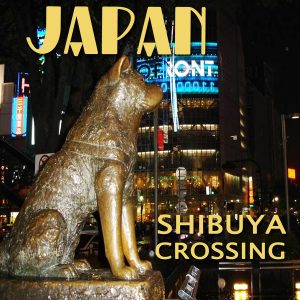45. Japan (Shibuya Crossing, Tokyo)
21 April 2024
One of the first lessons in loss for our younger boys was when our lovely Akita died in 2004. Ina-san had come into our lives three years before in New Zealand, when we’d stayed with Brian’s brother Les for our wedding, and we all fell in love with her massive frame and gentle nature. Though placid and obedient (as long as the commands were in Japanese) like a lot of Akitas she wasn’t a people dog, but was devoted to Les and extended that to all of us. When he moved back to Australia and then went travelling indefinitely, Ina naturally came to live with the family.
For all the concerns about Akitas’ size and potential aggression (they were originally bred for hunting bear and tracking prisoners) Ina was especially protective of the boys. But it was the legendary loyalty of the breed that we most recognised in her. When Les departed she seemed to understand his absence wouldn’t be brief and sighed long and loudly, then rather than her usual aloofness, she stuck obsessively to each of us… perhaps wondering if her home here was also only temporary. We understood her insecurities but unfortunately made them worse a couple of years later when we had to leave her in boarding kennels for a week.
Ina had never been away from her humans, apart from a brief quarantine when she first arrived in Australia, but the Rainbow Beach holiday park where we celebrated Mum and Dad’s 50th wedding anniversary had a strict no-animals policy. A couple of friends tentatively offered to mind her but were not confident they could deal with her many anxieties or restrain her if she became stressed and tried to leave. Her size and 60kg weight also limited the choices of local “pet resorts”, as the recommended ones said she was outside the capacity of their kennels. The one that could board her came with mixed reviews and while the owner was pleasant enough and did seem to have an affinity with the dogs in his care, we could not know what she was thinking as we drove away. That sad-eyed expression (a feature of Akitas) followed us on the quiet ride south and when we got a call three days later to say she’d died suddenly, our shock and devastation was mixed with a lot of guilt. The cause of death was unclear… possibly snakebite, though they found no evidence of that under her double-thick coat. An undiagnosed health issue maybe, but she had been declared in excellent shape at her recent checkup. In the vet’s opinion it was probably just age; she was 11, close to the 12 to 15 years life expectancy of Akitas, but we were dubious. Her pure breeding and magnificent looks inspired a few abduction theories… a stretch, for sure, but any scenario was preferable to the thought of her broken-hearted, believing we had just abandoned her.
It drew to mind the story of Japan’s famous Akita, Hachikō, whose habit of waiting every day at Shibuya railway station for his owner’s return from work, continued even after Professor Ueno suffered a fatal brain haemorrhage in 1925 and didn’t make the commute. For the rest of Hachikō’s life, no one could stop his resolute plod to meet the 3:00pm train, and a daily vigil that lasted until he died in 1934. By then he was nationally famous and a bronze statue was erected at the station to honour his faith and patience. It was melted down for munitions during WWII but a new monument was commissioned after the war and each year, on March 8, a ceremony of remembrance is held at the site. In memory of Ina – and no doubt reminiscing about his beloved childhood pup (see the Dog on the Tuckerbox ashdrop in Randoms) Brian wanted to visit the statue one day and made it the original ‘J’ on his list.
Hachikō also lived for 11 years, but instead of being interred under a camphor laurel like our old girl, he was cremated and his ashes buried beside his master. His fur is still on display at Tokyo’s National Science Museum and in 2011, scientists were able to determine that his cause of death was terminal cancer and a filaria infection. Bizarrely, there had also been four yakitori skewers found in his stomach, but these were not thought to be contributing factors.
Japan was one of the last countries to reopen to casual visitors after covid lockdowns but my unfamiliar nerves about solo travel there were more to do with the health challenges I’d experienced since my last overseas trip. Tour groups were an option but had never appealed… until I saw the Backroads of Japan itinerary and booked what turned out to be a cracker couple of weeks sharing new adventures with new people. The simplicity of not having to organise the details was a mental vacation in itself and the tour included so many experiences I might otherwise have missed. On Day 2 we did a walking tour of Shinjuku and Shibuya and I soon found myself lined up with the throng for a photo op with bronze Hachikō. Like Snake Gully’s Dog on the Tuckerbox, the monument is much smaller than I’d imagined but it certainly draws a crowd and has become a popular meeting spot for locals and tourists. Arguments have broken out when some queue jump or their posing takes too long, but though I was culpable on both counts, no one seemed to mind. Sprinkling a bit of Brian was met with curiosity but it would not be the first time someone had scattered ashes at the feet of this canine hero.









